Author: Wind complains about Jiangnan origin: https://www.cnblogs.com/mengjinxiang The author is original, the article is welcome to reprint, if you like, please comment + attention, thank you for your support!
Foreword: Recently I have been writing Python related technical blogs on other blog Forums - > https://blog.csdn.net/JackMengJin Plan to write scattered technical points about installation, troubleshooting, pit climbing, etc. on the blog park to make it feel better (mild obsessive-compulsive disorder patients = =).
Operation:
1. What is HTMLTestRunner?
No HTMLTestRunner explanations were found online, including in the Python official library.In fact, HTMLTestRunner is a third-party unittest HTML repository, and it is easy to find about unittest on the official Python library: https://docs.python.org/zh-cn/3.7/library/unittest.html#assert-methods , the following is a partial explanation of the intercept:
unittest The unit test framework is inspired by JUnit and has a similar style to the mainstream unit test framework in other languages.It supports test automation, configuration sharing, and off-machine code testing.Supports aggregating test samples into test sets and making tests independent of the reporting framework.
To achieve these, unittest Important concepts are supported through an object-oriented approach.
Test scaffolding
test fixture represents the preparation required to run one or more tests, as well as all associated cleanup operations.For example, this might include creating a temporary or proxy database, directory, or starting a server process.
test case
A test case is a stand-alone test unit.It checks the response when specific data is entered.( unittest Provide a base class: TestCase For new test cases.
test suite
A test suite is a series of test cases, or test suites, or both.It is used to archive tests that need to be executed together.
test runner
test runner is a component used to execute and output test results.This runner may use a graphical interface, a text interface, or return a specific value representing the results of running the test.
unittest The module provides a series of tools to create and run tests.This paragraph demonstrates a small portion of these tools, but it is sufficient to meet the needs of most users.
This is a short piece of code to test three string methods:
import unittest
class TestStringMethods(unittest.TestCase):
def test_upper(self):
self.assertEqual('foo'.upper(), 'FOO')
def test_isupper(self):
self.assertTrue('FOO'.isupper())
self.assertFalse('Foo'.isupper())
def test_split(self):
s = 'hello world'
self.assertEqual(s.split(), ['hello', 'world'])
# check that s.split fails when the separator is not a string
with self.assertRaises(TypeError):
s.split(2)
if __name__ == '__main__':
unittest.main()
From the above data, you can see that unittest can output a text execution report in txt format, but the text report is too simple, do you want a taller HTML report?
But unittest itself doesn't have an HTML report, so we can only turn to an external library, HTMLTestRunner.py.
2. Download HTMLTestRunner.py
Why download HTMLTestRunner.py instead of HTMLTestRunner directly?
Before revealing the answer, we download the HTMLTestRunner using the usual tools:
- Download HTMLTestRunner from Pycharm
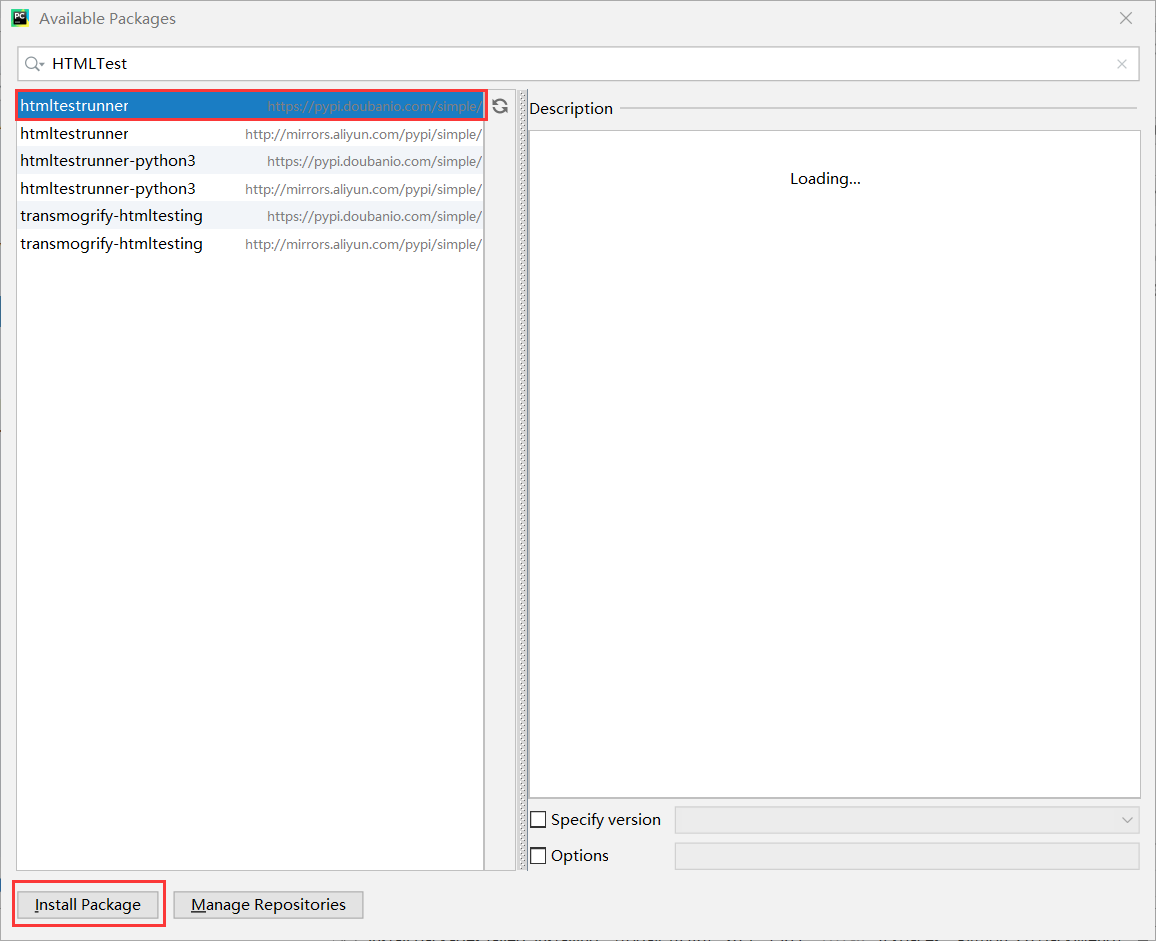
Make sure you are using Douban Source for download, then click Install:
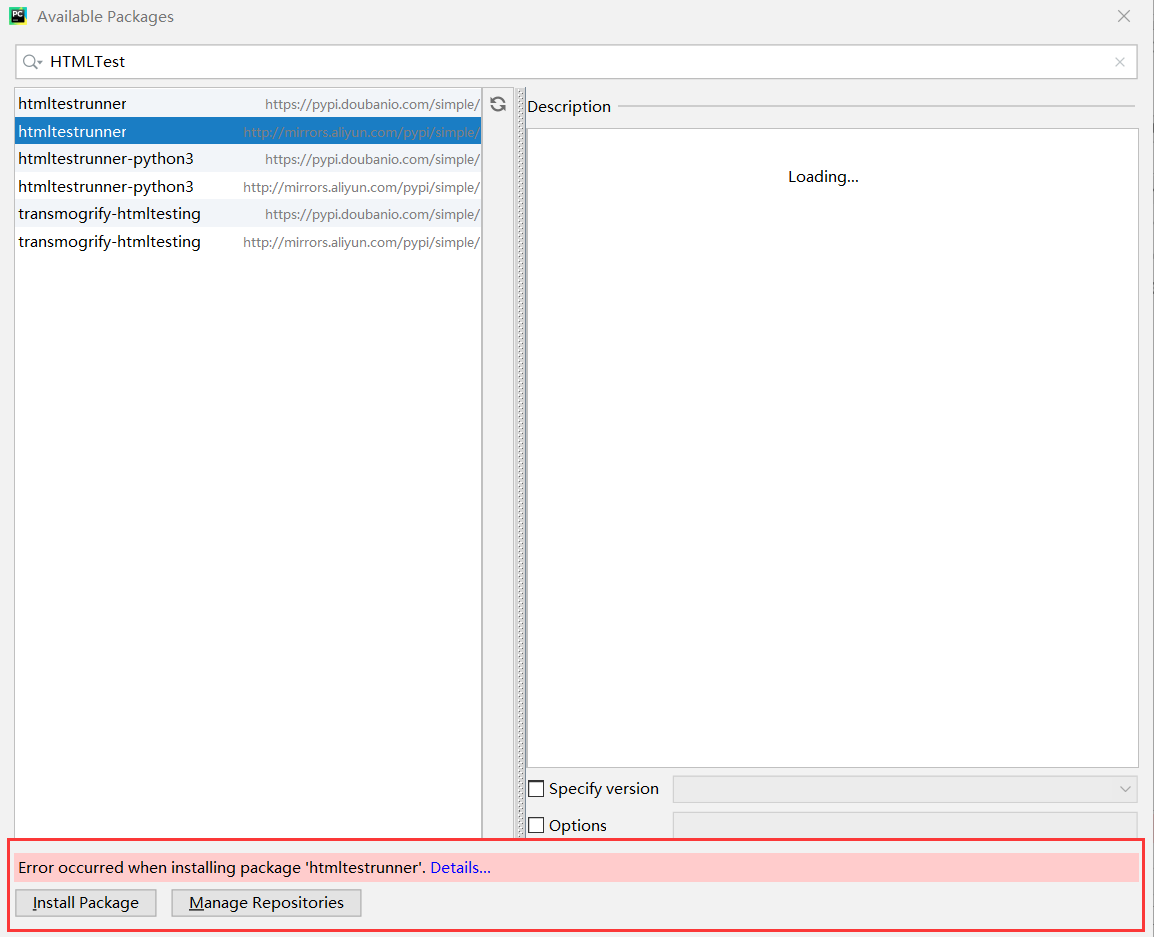
If it did, why did it make a mistake?
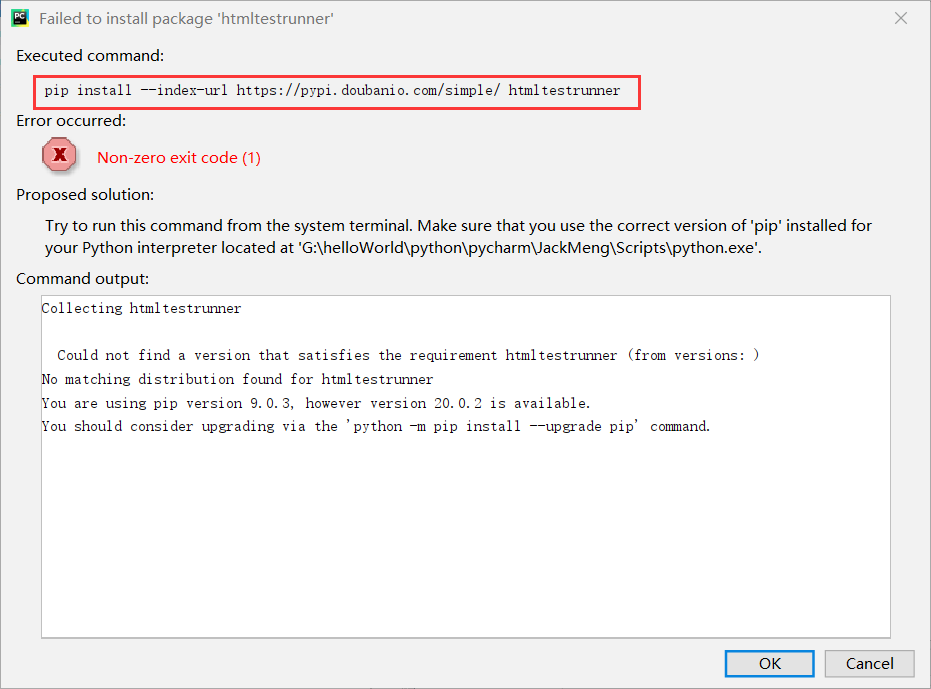
- Download HTMLTestRunner from pip
Here I'll try pip download again:
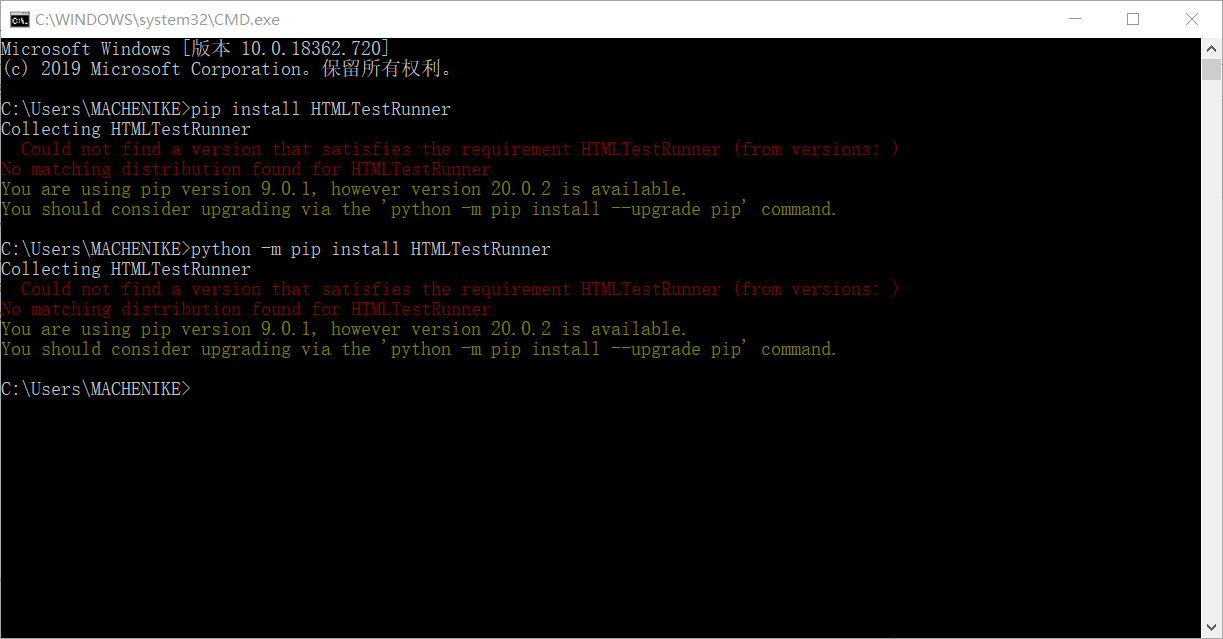
It turns out that no matter how you try, you won't be able to:
So I looked at the following data and came to the conclusion that the reason is that HTMLTestRunner is an extension of the unittest module of the Python standard library and cannot be installed through pip.
So how do we use and download the HTMLTestRunner?
In fact, the solution is simple, you need to manually download the HTMLTestRunner.py file and place it in the python directory Lib folder:
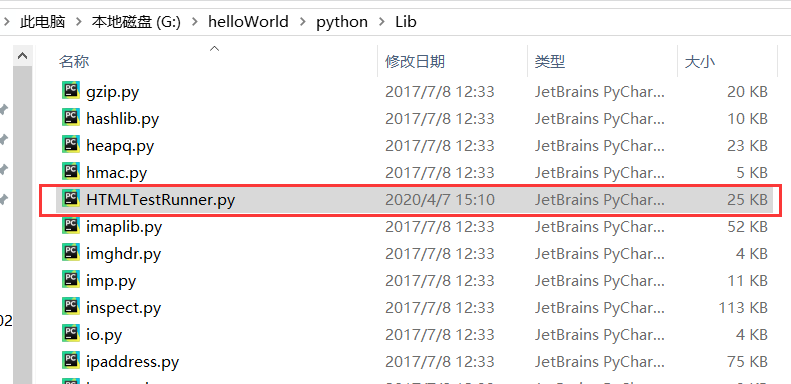
Since Python 2.x is no longer used in the vast majority of cases, here's the HTMLestRunner.py file that supports Python 3.x:
""" A TestRunner for use with the Python unit testing framework. It generates a HTML report to show the result at a glance. The simplest way to use this is to invoke its main method. E.g. import unittest import HTMLTestRunner ... define your tests ... if __name__ == '__main__': HTMLTestRunner.main() For more customization options, instantiates a HTMLTestRunner object. HTMLTestRunner is a counterpart to unittest's TextTestRunner. E.g. # output to a file fp = file('my_report.html', 'wb') runner = HTMLTestRunner.HTMLTestRunner( stream=fp, title='My unit test', description='This demonstrates the report output by HTMLTestRunner.' ) # Use an external stylesheet. # See the Template_mixin class for more customizable options runner.STYLESHEET_TMPL = '<link rel="stylesheet" href="my_stylesheet.css" type="text/css">' # run the test runner.run(my_test_suite) ------------------------------------------------------------------------ Copyright (c) 2004-2007, Wai Yip Tung All rights reserved. Redistribution and use in source and binary forms, with or without modification, are permitted provided that the following conditions are met: * Redistributions of source code must retain the above copyright notice, this list of conditions and the following disclaimer. * Redistributions in binary form must reproduce the above copyright notice, this list of conditions and the following disclaimer in the documentation and/or other materials provided with the distribution. * Neither the name Wai Yip Tung nor the names of its contributors may be used to endorse or promote products derived from this software without specific prior written permission. THIS SOFTWARE IS PROVIDED BY THE COPYRIGHT HOLDERS AND CONTRIBUTORS "AS IS" AND ANY EXPRESS OR IMPLIED WARRANTIES, INCLUDING, BUT NOT LIMITED TO, THE IMPLIED WARRANTIES OF MERCHANTABILITY AND FITNESS FOR A PARTICULAR PURPOSE ARE DISCLAIMED. IN NO EVENT SHALL THE COPYRIGHT OWNER OR CONTRIBUTORS BE LIABLE FOR ANY DIRECT, INDIRECT, INCIDENTAL, SPECIAL, EXEMPLARY, OR CONSEQUENTIAL DAMAGES (INCLUDING, BUT NOT LIMITED TO, PROCUREMENT OF SUBSTITUTE GOODS OR SERVICES; LOSS OF USE, DATA, OR PROFITS; OR BUSINESS INTERRUPTION) HOWEVER CAUSED AND ON ANY THEORY OF LIABILITY, WHETHER IN CONTRACT, STRICT LIABILITY, OR TORT (INCLUDING NEGLIGENCE OR OTHERWISE) ARISING IN ANY WAY OUT OF THE USE OF THIS SOFTWARE, EVEN IF ADVISED OF THE POSSIBILITY OF SUCH DAMAGE. """ # URL: http://tungwaiyip.info/software/HTMLTestRunner.html __author__ = "Wai Yip Tung" __version__ = "0.8.2" """ Change History Version 0.8.2 * Show output inline instead of popup window (Viorel Lupu). Version in 0.8.1 * Validated XHTML (Wolfgang Borgert). * Added description of test classes and test cases. Version in 0.8.0 * Define Template_mixin class for customization. * Workaround a IE 6 bug that it does not treat <script> block as CDATA. Version in 0.7.1 * Back port to Python 2.3 (Frank Horowitz). * Fix missing scroll bars in detail log (Podi). """ # TODO: color stderr # TODO: simplify javascript using ,ore than 1 class in the class attribute? import datetime #2.7 Version is import StringIO import io import sys import time import unittest from xml.sax import saxutils # ------------------------------------------------------------------------ # The redirectors below are used to capture output during testing. Output # sent to sys.stdout and sys.stderr are automatically captured. However # in some cases sys.stdout is already cached before HTMLTestRunner is # invoked (e.g. calling logging.basicConfig). In order to capture those # output, use the redirectors for the cached stream. # # e.g. # >>> logging.basicConfig(stream=HTMLTestRunner.stdout_redirector) # >>> class OutputRedirector(object): """ Wrapper to redirect stdout or stderr """ def __init__(self, fp): self.fp = fp def write(self, s): self.fp.write(s) def writelines(self, lines): self.fp.writelines(lines) def flush(self): self.fp.flush() stdout_redirector = OutputRedirector(sys.stdout) stderr_redirector = OutputRedirector(sys.stderr) # ---------------------------------------------------------------------- # Template class Template_mixin(object): """ Define a HTML template for report customerization and generation. Overall structure of an HTML report HTML +------------------------+ |<html> | | <head> | | | | STYLESHEET | | +----------------+ | | | | | | +----------------+ | | | | </head> | | | | <body> | | | | HEADING | | +----------------+ | | | | | | +----------------+ | | | | REPORT | | +----------------+ | | | | | | +----------------+ | | | | ENDING | | +----------------+ | | | | | | +----------------+ | | | | </body> | |</html> | +------------------------+ """ STATUS = { 0: 'pass', 1: 'fail', 2: 'error', } DEFAULT_TITLE = 'Unit Test Report' DEFAULT_DESCRIPTION = '' # ------------------------------------------------------------------------ # HTML Template HTML_TMPL = r"""<?xml version="1.0" encoding="UTF-8"?> <!DOCTYPE html PUBLIC "-//W3C//DTD XHTML 1.0 Strict//EN" "http://www.w3.org/TR/xhtml1/DTD/xhtml1-strict.dtd"> <html xmlns="http://www.w3.org/1999/xhtml"> <head> <title>%(title)s</title> <meta name="generator" content="%(generator)s"/> <meta http-equiv="Content-Type" content="text/html; charset=UTF-8"/> %(stylesheet)s </head> <body> <script language="javascript" type="text/javascript"><!-- output_list = Array(); /* level - 0:Summary; 1:Failed; 2:All */ function showCase(level) { trs = document.getElementsByTagName("tr"); for (var i = 0; i < trs.length; i++) { tr = trs[i]; id = tr.id; if (id.substr(0,2) == 'ft') { if (level < 1) { tr.className = 'hiddenRow'; } else { tr.className = ''; } } if (id.substr(0,2) == 'pt') { if (level > 1) { tr.className = ''; } else { tr.className = 'hiddenRow'; } } } } function showClassDetail(cid, count) { var id_list = Array(count); var toHide = 1; for (var i = 0; i < count; i++) { tid0 = 't' + cid.substr(1) + '.' + (i+1); tid = 'f' + tid0; tr = document.getElementById(tid); if (!tr) { tid = 'p' + tid0; tr = document.getElementById(tid); } id_list[i] = tid; if (tr.className) { toHide = 0; } } for (var i = 0; i < count; i++) { tid = id_list[i]; if (toHide) { document.getElementById('div_'+tid).style.display = 'none' document.getElementById(tid).className = 'hiddenRow'; } else { document.getElementById(tid).className = ''; } } } function showTestDetail(div_id){ var details_div = document.getElementById(div_id) var displayState = details_div.style.display // alert(displayState) if (displayState != 'block' ) { displayState = 'block' details_div.style.display = 'block' } else { details_div.style.display = 'none' } } function html_escape(s) { s = s.replace(/&/g,'&'); s = s.replace(/</g,'<'); s = s.replace(/>/g,'>'); return s; } /* obsoleted by detail in <div> function showOutput(id, name) { var w = window.open("", //url name, "resizable,scrollbars,status,width=800,height=450"); d = w.document; d.write("<pre>"); d.write(html_escape(output_list[id])); d.write("\n"); d.write("<a href='javascript:window.close()'>close</a>\n"); d.write("</pre>\n"); d.close(); } */ --></script> %(heading)s %(report)s %(ending)s </body> </html> """ # variables: (title, generator, stylesheet, heading, report, ending) # ------------------------------------------------------------------------ # Stylesheet # # alternatively use a <link> for external style sheet, e.g. # <link rel="stylesheet" href="$url" type="text/css"> STYLESHEET_TMPL = """ <style type="text/css" media="screen"> body { font-family: verdana, arial, helvetica, sans-serif; font-size: 80%; } table { font-size: 100%; } pre { } /* -- heading ---------------------------------------------------------------------- */ h1 { font-size: 16pt; color: gray; } .heading { margin-top: 0ex; margin-bottom: 1ex; } .heading .attribute { margin-top: 1ex; margin-bottom: 0; } .heading .description { margin-top: 4ex; margin-bottom: 6ex; } /* -- css div popup ------------------------------------------------------------------------ */ a.popup_link { } a.popup_link:hover { color: red; } .popup_window { display: none; position: relative; left: 0px; top: 0px; /*border: solid #627173 1px; */ padding: 10px; background-color: #E6E6D6; font-family: "Lucida Console", "Courier New", Courier, monospace; text-align: left; font-size: 8pt; width: 500px; } } /* -- report ------------------------------------------------------------------------ */ #show_detail_line { margin-top: 3ex; margin-bottom: 1ex; } #result_table { width: 80%; border-collapse: collapse; border: 1px solid #777; } #header_row { font-weight: bold; color: white; background-color: #777; } #result_table td { border: 1px solid #777; padding: 2px; } #total_row { font-weight: bold; } .passClass { background-color: #6c6; } .failClass { background-color: #c60; } .errorClass { background-color: #c00; } .passCase { color: #6c6; } .failCase { color: #c60; font-weight: bold; } .errorCase { color: #c00; font-weight: bold; } .hiddenRow { display: none; } .testcase { margin-left: 2em; } /* -- ending ---------------------------------------------------------------------- */ #ending { } </style> """ # ------------------------------------------------------------------------ # Heading # HEADING_TMPL = """<div class='heading'> <h1>%(title)s</h1> %(parameters)s <p class='description'>%(description)s</p> </div> """ # variables: (title, parameters, description) HEADING_ATTRIBUTE_TMPL = """<p class='attribute'><strong>%(name)s:</strong> %(value)s</p> """ # variables: (name, value) # ------------------------------------------------------------------------ # Report # REPORT_TMPL = """ <p id='show_detail_line'>Show <a href='javascript:showCase(0)'>Summary</a> <a href='javascript:showCase(1)'>Failed</a> <a href='javascript:showCase(2)'>All</a> </p> <table id='result_table'> <colgroup> <col align='left' /> <col align='right' /> <col align='right' /> <col align='right' /> <col align='right' /> <col align='right' /> </colgroup> <tr id='header_row'> <td>Test Group/Test case</td> <td>Count</td> <td>Pass</td> <td>Fail</td> <td>Error</td> <td>View</td> </tr> %(test_list)s <tr id='total_row'> <td>Total</td> <td>%(count)s</td> <td>%(Pass)s</td> <td>%(fail)s</td> <td>%(error)s</td> <td> </td> </tr> </table> """ # variables: (test_list, count, Pass, fail, error) REPORT_CLASS_TMPL = r""" <tr class='%(style)s'> <td>%(desc)s</td> <td>%(count)s</td> <td>%(Pass)s</td> <td>%(fail)s</td> <td>%(error)s</td> <td><a href="javascript:showClassDetail('%(cid)s',%(count)s)">Detail</a></td> </tr> """ # variables: (style, desc, count, Pass, fail, error, cid) REPORT_TEST_WITH_OUTPUT_TMPL = r""" <tr id='%(tid)s' class='%(Class)s'> <td class='%(style)s'><div class='testcase'>%(desc)s</div></td> <td colspan='5' align='center'> <!--css div popup start--> <a class="popup_link" onfocus='this.blur();' href="javascript:showTestDetail('div_%(tid)s')" > %(status)s</a> <div id='div_%(tid)s' class="popup_window"> <div style='text-align: right; color:red;cursor:pointer'> <a onfocus='this.blur();' onclick="document.getElementById('div_%(tid)s').style.display = 'none' " > [x]</a> </div> <pre> %(script)s </pre> </div> <!--css div popup end--> </td> </tr> """ # variables: (tid, Class, style, desc, status) REPORT_TEST_NO_OUTPUT_TMPL = r""" <tr id='%(tid)s' class='%(Class)s'> <td class='%(style)s'><div class='testcase'>%(desc)s</div></td> <td colspan='5' align='center'>%(status)s</td> </tr> """ # variables: (tid, Class, style, desc, status) REPORT_TEST_OUTPUT_TMPL = r""" %(id)s: %(output)s """ # variables: (id, output) # ------------------------------------------------------------------------ # ENDING # ENDING_TMPL = """<div id='ending'> </div>""" # -------------------- The end of the Template class ------------------- TestResult = unittest.TestResult class _TestResult(TestResult): # note: _TestResult is a pure representation of results. # It lacks the output and reporting ability compares to unittest._TextTestResult. def __init__(self, verbosity=1): TestResult.__init__(self) self.stdout0 = None self.stderr0 = None self.success_count = 0 self.failure_count = 0 self.error_count = 0 self.verbosity = verbosity # result is a list of result in 4 tuple # ( # result code (0: success; 1: fail; 2: error), # TestCase object, # Test output (byte string), # stack trace, # ) self.result = [] def startTest(self, test): TestResult.startTest(self, test) # just one buffer for both stdout and stderr # 2.7 Version is self.outputBuffer = StringIO.StringIO() self.outputBuffer = io.StringIO() stdout_redirector.fp = self.outputBuffer stderr_redirector.fp = self.outputBuffer self.stdout0 = sys.stdout self.stderr0 = sys.stderr sys.stdout = stdout_redirector sys.stderr = stderr_redirector def complete_output(self): """ Disconnect output redirection and return buffer. Safe to call multiple times. """ if self.stdout0: sys.stdout = self.stdout0 sys.stderr = self.stderr0 self.stdout0 = None self.stderr0 = None return self.outputBuffer.getvalue() def stopTest(self, test): # Usually one of addSuccess, addError or addFailure would have been called. # But there are some path in unittest that would bypass this. # We must disconnect stdout in stopTest(), which is guaranteed to be called. self.complete_output() def addSuccess(self, test): self.success_count += 1 TestResult.addSuccess(self, test) output = self.complete_output() self.result.append((0, test, output, '')) if self.verbosity > 1: sys.stderr.write('ok ') sys.stderr.write(str(test)) sys.stderr.write('\n') else: sys.stderr.write('.') def addError(self, test, err): self.error_count += 1 TestResult.addError(self, test, err) _, _exc_str = self.errors[-1] output = self.complete_output() self.result.append((2, test, output, _exc_str)) if self.verbosity > 1: sys.stderr.write('E ') sys.stderr.write(str(test)) sys.stderr.write('\n') else: sys.stderr.write('E') def addFailure(self, test, err): self.failure_count += 1 TestResult.addFailure(self, test, err) _, _exc_str = self.failures[-1] output = self.complete_output() self.result.append((1, test, output, _exc_str)) if self.verbosity > 1: sys.stderr.write('F ') sys.stderr.write(str(test)) sys.stderr.write('\n') else: sys.stderr.write('F') class HTMLTestRunner(Template_mixin): """ """ def __init__(self, stream=sys.stdout, verbosity=1, title=None, description=None): self.stream = stream self.verbosity = verbosity if title is None: self.title = self.DEFAULT_TITLE else: self.title = title if description is None: self.description = self.DEFAULT_DESCRIPTION else: self.description = description self.startTime = datetime.datetime.now() def run(self, test): "Run the given test case or test suite." result = _TestResult(self.verbosity) test(result) self.stopTime = datetime.datetime.now() self.generateReport(test, result) print(sys.stderr,'\nTime Elapsed=%s' %(self.stopTime-self.startTime)) #2.7 Edition print >>sys.stderr, '\nTime Elapsed: %s' % (self.stopTime-self.startTime) return result def sortResult(self, result_list): # unittest does not seems to run in any particular order. # Here at least we want to group them together by class. rmap = {} classes = [] for n,t,o,e in result_list: cls = t.__class__ # 2.7 Edition if not rmap.has_key(cls) if not cls in rmap: rmap[cls] = [] classes.append(cls) rmap[cls].append((n,t,o,e)) r = [(cls, rmap[cls]) for cls in classes] return r def getReportAttributes(self, result): """ Return report attributes as a list of (name, value). Override this to add custom attributes. """ startTime = str(self.startTime)[:19] duration = str(self.stopTime - self.startTime) status = [] if result.success_count: status.append('Pass %s' % result.success_count) if result.failure_count: status.append('Failure %s' % result.failure_count) if result.error_count: status.append('Error %s' % result.error_count ) if status: status = ' '.join(status) else: status = 'none' return [ ('Start Time', startTime), ('Duration', duration), ('Status', status), ] def generateReport(self, test, result): report_attrs = self.getReportAttributes(result) generator = 'HTMLTestRunner %s' % __version__ stylesheet = self._generate_stylesheet() heading = self._generate_heading(report_attrs) report = self._generate_report(result) ending = self._generate_ending() output = self.HTML_TMPL % dict( title = saxutils.escape(self.title), generator = generator, stylesheet = stylesheet, heading = heading, report = report, ending = ending, ) self.stream.write(output.encode('utf8')) def _generate_stylesheet(self): return self.STYLESHEET_TMPL def _generate_heading(self, report_attrs): a_lines = [] for name, value in report_attrs: line = self.HEADING_ATTRIBUTE_TMPL % dict( name = saxutils.escape(name), value = saxutils.escape(value), ) a_lines.append(line) heading = self.HEADING_TMPL % dict( title = saxutils.escape(self.title), parameters = ''.join(a_lines), description = saxutils.escape(self.description), ) return heading def _generate_report(self, result): rows = [] sortedResult = self.sortResult(result.result) for cid, (cls, cls_results) in enumerate(sortedResult): # subtotal for a class np = nf = ne = 0 for n,t,o,e in cls_results: if n == 0: np += 1 elif n == 1: nf += 1 else: ne += 1 # format class description if cls.__module__ == "__main__": name = cls.__name__ else: name = "%s.%s" % (cls.__module__, cls.__name__) doc = cls.__doc__ and cls.__doc__.split("\n")[0] or "" desc = doc and '%s: %s' % (name, doc) or name row = self.REPORT_CLASS_TMPL % dict( style = ne > 0 and 'errorClass' or nf > 0 and 'failClass' or 'passClass', desc = desc, count = np+nf+ne, Pass = np, fail = nf, error = ne, cid = 'c%s' % (cid+1), ) rows.append(row) for tid, (n,t,o,e) in enumerate(cls_results): self._generate_report_test(rows, cid, tid, n, t, o, e) report = self.REPORT_TMPL % dict( test_list = ''.join(rows), count = str(result.success_count+result.failure_count+result.error_count), Pass = str(result.success_count), fail = str(result.failure_count), error = str(result.error_count), ) return report def _generate_report_test(self, rows, cid, tid, n, t, o, e): # e.g. 'pt1.1', 'ft1.1', etc has_output = bool(o or e) tid = (n == 0 and 'p' or 'f') + 't%s.%s' % (cid+1,tid+1) name = t.id().split('.')[-1] doc = t.shortDescription() or "" desc = doc and ('%s: %s' % (name, doc)) or name tmpl = has_output and self.REPORT_TEST_WITH_OUTPUT_TMPL or self.REPORT_TEST_NO_OUTPUT_TMPL # o and e should be byte string because they are collected from stdout and stderr? if isinstance(o,str): uo = e # TODO: some problem with 'string_escape': it escape \n and mess up formating # uo = unicode(o.encode('string_escape')) # 2.7 Edition uo = o.decode('latin-1') else: uo = o if isinstance(e,str): ue = e # TODO: some problem with 'string_escape': it escape \n and mess up formating # ue = unicode(e.encode('string_escape')) # 2.7 Edition ue = e.decode('latin-1') else: ue = e script = self.REPORT_TEST_OUTPUT_TMPL % dict( id = tid, output = saxutils.escape(uo+ue), ) row = tmpl % dict( tid = tid, Class = (n == 0 and 'hiddenRow' or 'none'), style = n == 2 and 'errorCase' or (n == 1 and 'failCase' or 'none'), desc = desc, script = script, status = self.STATUS[n], ) rows.append(row) if not has_output: return def _generate_ending(self): return self.ENDING_TMPL ############################################################################## # Facilities for running tests from the command line ############################################################################## # Note: Reuse unittest.TestProgram to launch test. In the future we may # build our own launcher to support more specific command line # parameters like test title, CSS, etc. class TestProgram(unittest.TestProgram): """ A variation of the unittest.TestProgram. Please refer to the base class for command line parameters. """ def runTests(self): # Pick HTMLTestRunner as the default test runner. # base class's testRunner parameter is not useful because it means # we have to instantiate HTMLTestRunner before we know self.verbosity. if self.testRunner is None: self.testRunner = HTMLTestRunner(verbosity=self.verbosity) unittest.TestProgram.runTests(self) main = TestProgram ############################################################################## # Executing this module from the command line ############################################################################## if __name__ == "__main__": main(module=None)
As to the specific differences between the two documents, interested children's shoes can search by themselves, this article will not expand on details.
3. How do I use HTMLTestRunner?
First, make sure you can use HTMLTestRunner:

No error?Go ahead, open Pycharm and copy and paste the following code:
import unittest import HTMLTestRunner class testadd(unittest.TestCase): def setUp(self): pass def test_add1(self): self.assertEqual(2 + 3 + 10,15) def test_add2(self): self.assertEqual(10 + 150,160) def test_add3(self): #One error, view test results self.assertEqual(2 * 5 * 7, 40) def tearDown(self): pass def suite(): suiteTest=unittest.TestSuite() suiteTest.addTest(testadd("test_add1")) suiteTest.addTest(testadd("test_add2")) suiteTest.addTest(testadd("test_add3")) return suiteTest if __name__=="__main__": # Store path in E Disk directory filepath='E:\\pyresult.html' fp=open(filepath,'wb') #Define the title and description of the test report runner = HTMLTestRunner.HTMLTestRunner(stream=fp,title=u'I am the title of the test report of Jiangnan',description=u'I am the wind complaining about the test report description of Jiangnan') runner.run(suite()) fp.close()
Run to see the results:
G:\helloWorld\python\pycharm\JackMeng\Scripts\python.exe G:/helloWorld/python/pycharm/JackMeng/HTMLTestRunner_demo.py <_io.TextIOWrapper name='<stderr>' mode='w' encoding='UTF-8'> Time Elapsed=0:00:00.000948 ..F
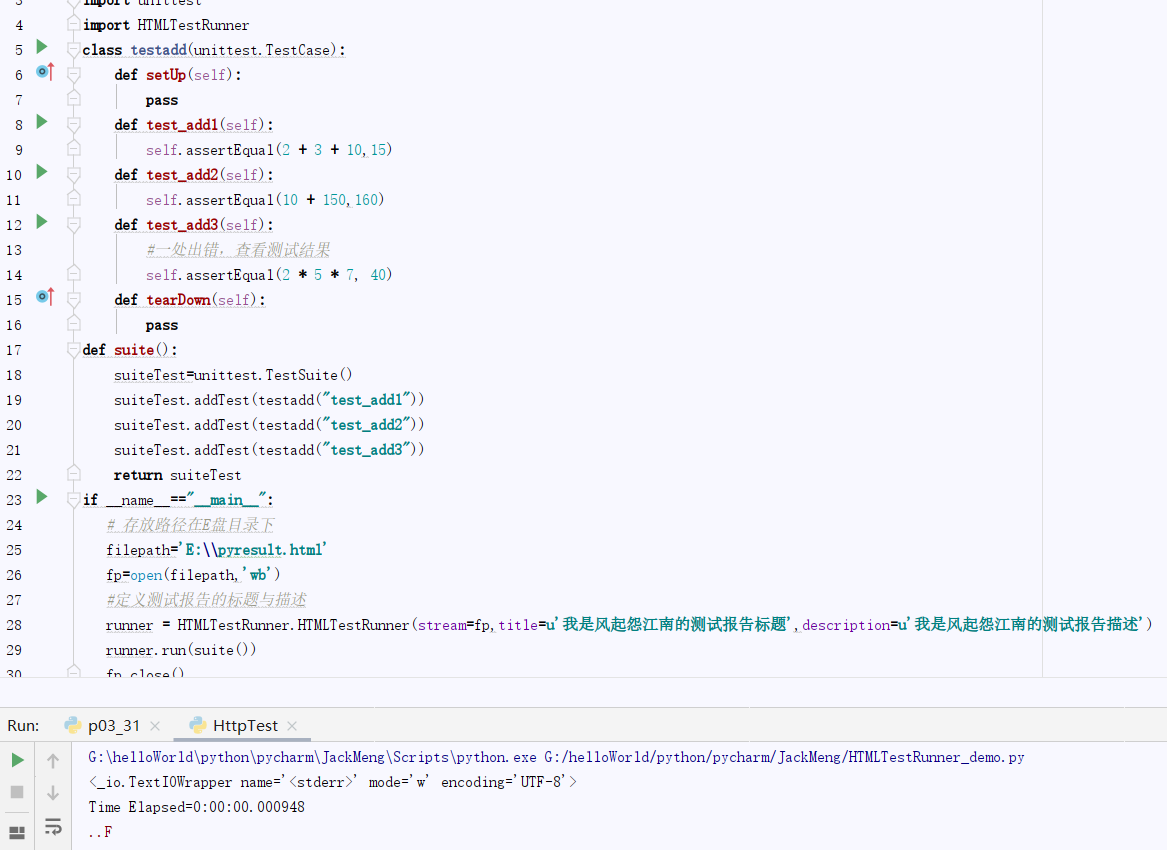
Do you have HTML test report files generated under drive E?
The answer is naturally generated:
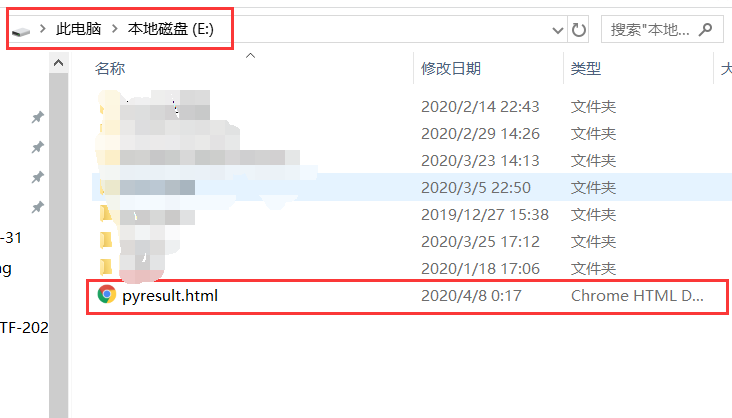
Click to see the test report:
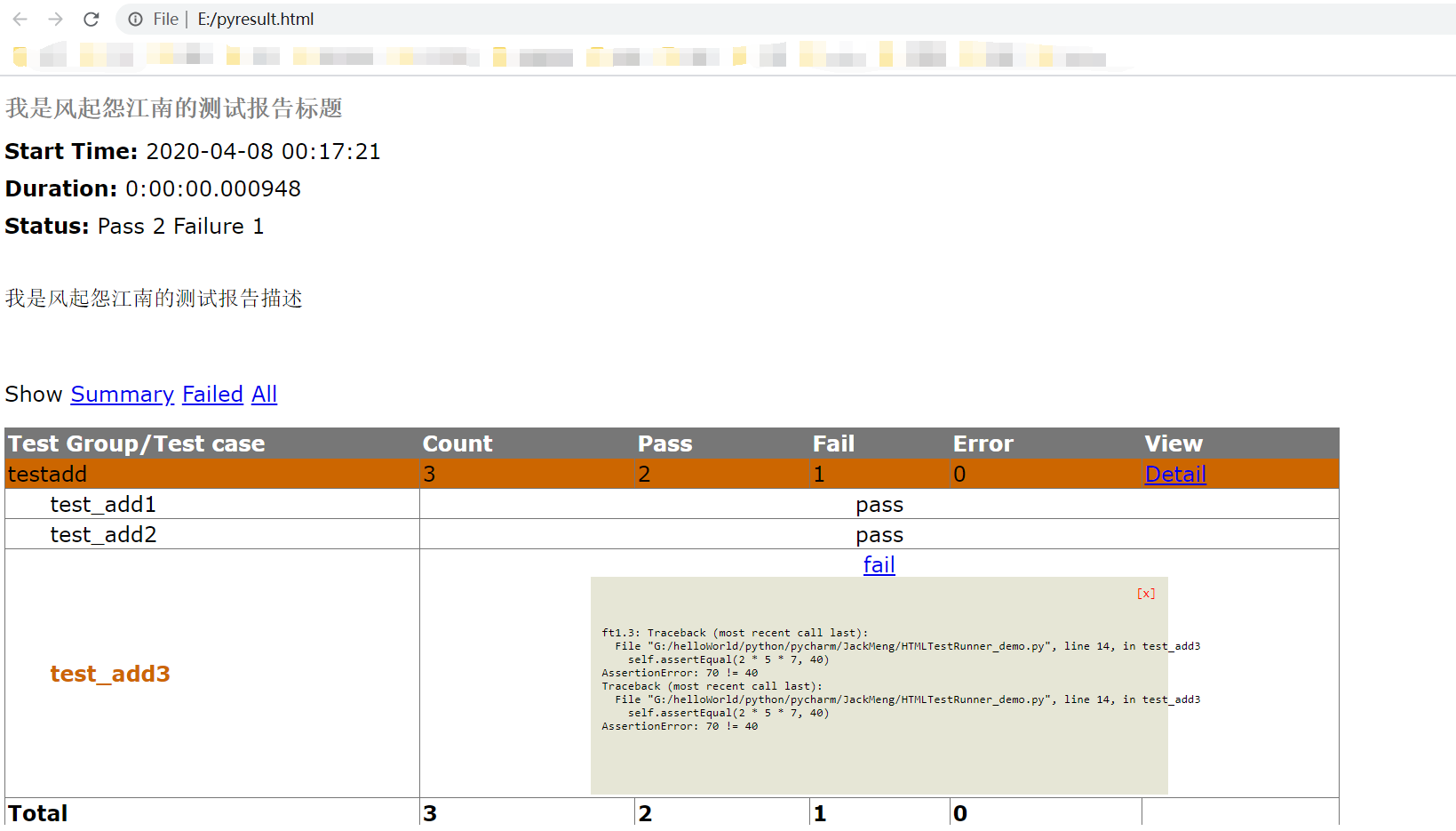
The test results are self-evident: perfect!
That's all about "Python 3.x Install HTMLTestRunner and Use". About "Wind Complaints Jiangnan" in the blog park, I will write more about program installation, troubleshooting, even some small programs and so on. There will be more wonderful blog posts in the future, so please pay attention to collecting a wave!
Of course, if you want to get more free learning materials, Please add my personal WeChat public number - complain about Jiangnan, and finally thank you for your attention and support!